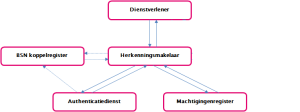This section describes the interface specifications for the traffic between all roles in the network. The messages are based on SAML 2.0, or XACML where applicable. |

The following requirements are valid for all interfaces.
The SAML Web Browser SSO Profile MUST be used for the interface described in this document. Optionally, an extension can be used for retrieving attributes.
Every SAML request message MAY contain RelayState data. The response to an SAML request with RelayState data MUST also contain this RelayState data. The content of the RelayState MUST NOT exceed 80 byte and MUST be protected against changes by the party creating the RelayState.
Perhaps superfluously, it must be said that the parties are free to choose the aliases they use for the abbreviations of namespaces in tags.
The following HTTP headers MUST be used for all content that is sent to the browser of a user:
Optional elements and attributes MAY be included in the messages. These elements MUST be populated according to the specifications and MUST NOT be empty.
Because different versions of the interface specifications (e.g. 1.9 and up) must be distinguished from each other at the interface level, message versioning MUST be used in the implemented interface. Because SAML 2.0 messages do not have a field for this and it is not desirable to use an extension in the messages, participants MUST link the URL on which SAML messages can be offered to a version of the framework in the published metadata. For example, https://www.deelnemer.nl/SAML-endpoint/v1.0/.
The same URL MUST NOT be used for two different versions of the framework. See also SAML metadata.
The language preference of the user can be specified, so the dialogue can take place in that language. Because SAML 2.0 messages do not have a field for this and it is not desirable to use an extension in the messages, EherkenningPreferredLanguage MAY be used as query variable in the URL or provided as POST variable. See also section SAML attribute elements.
All message MUST the Unicode character set. All characters MUST be UTF-8 encoded.
Contents of this chapter